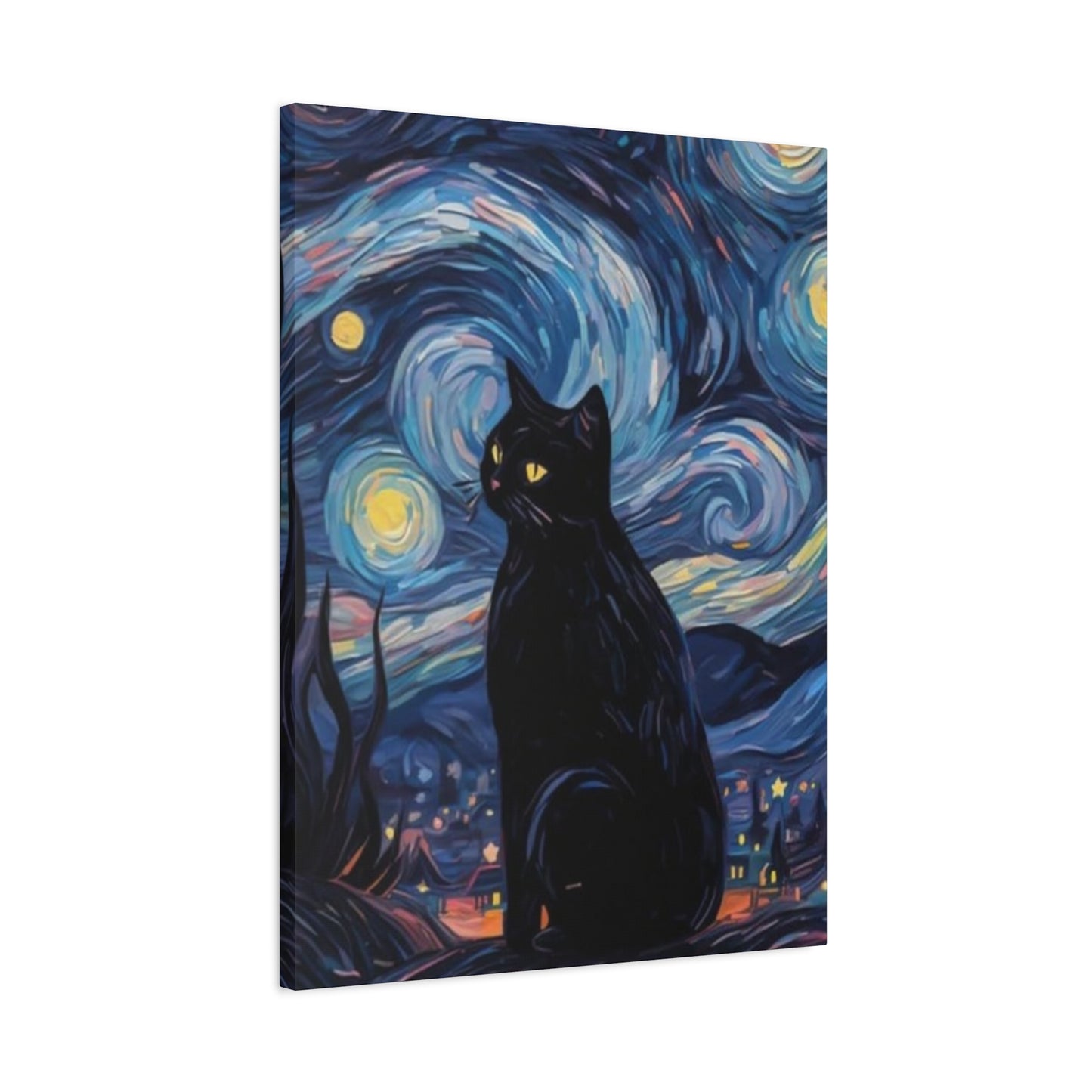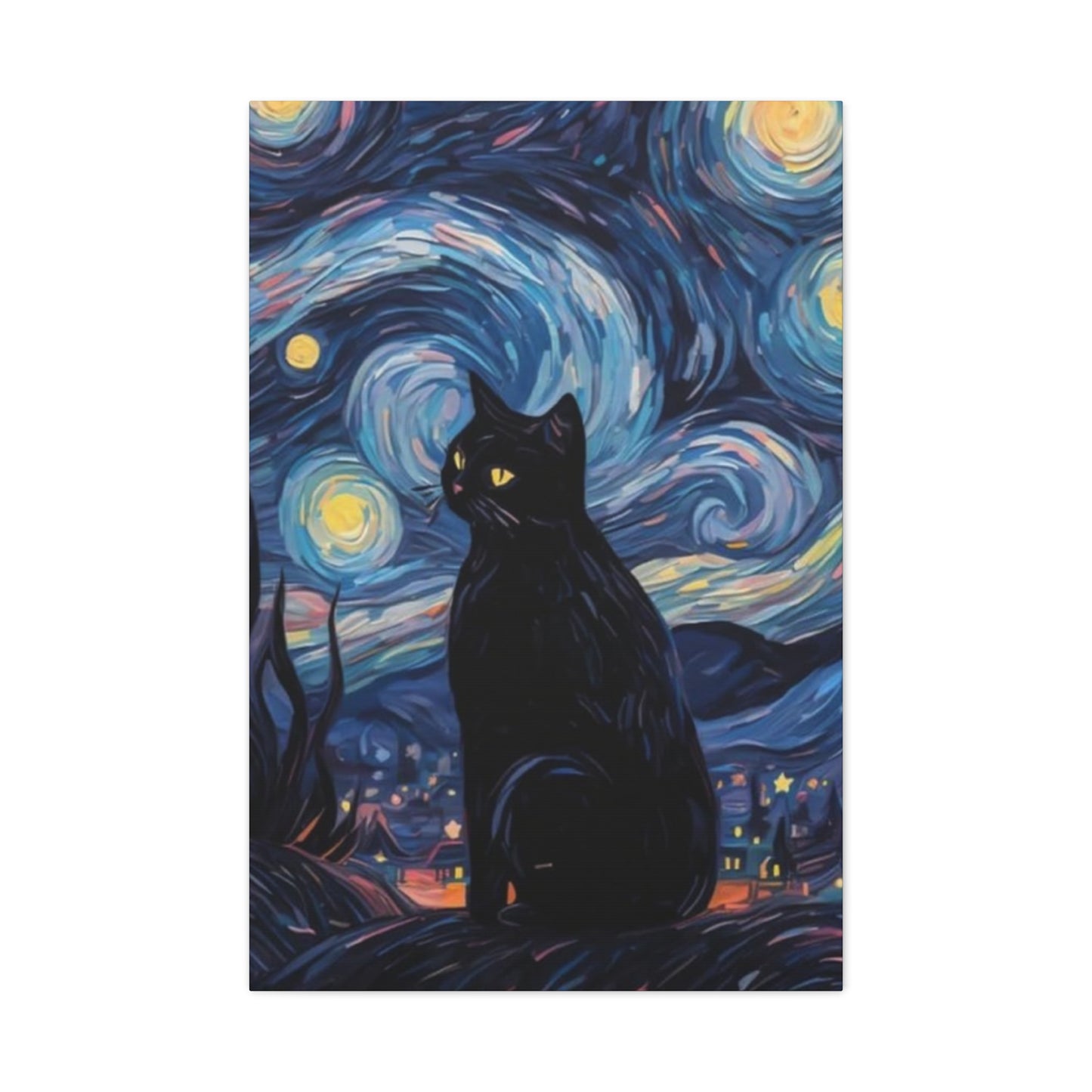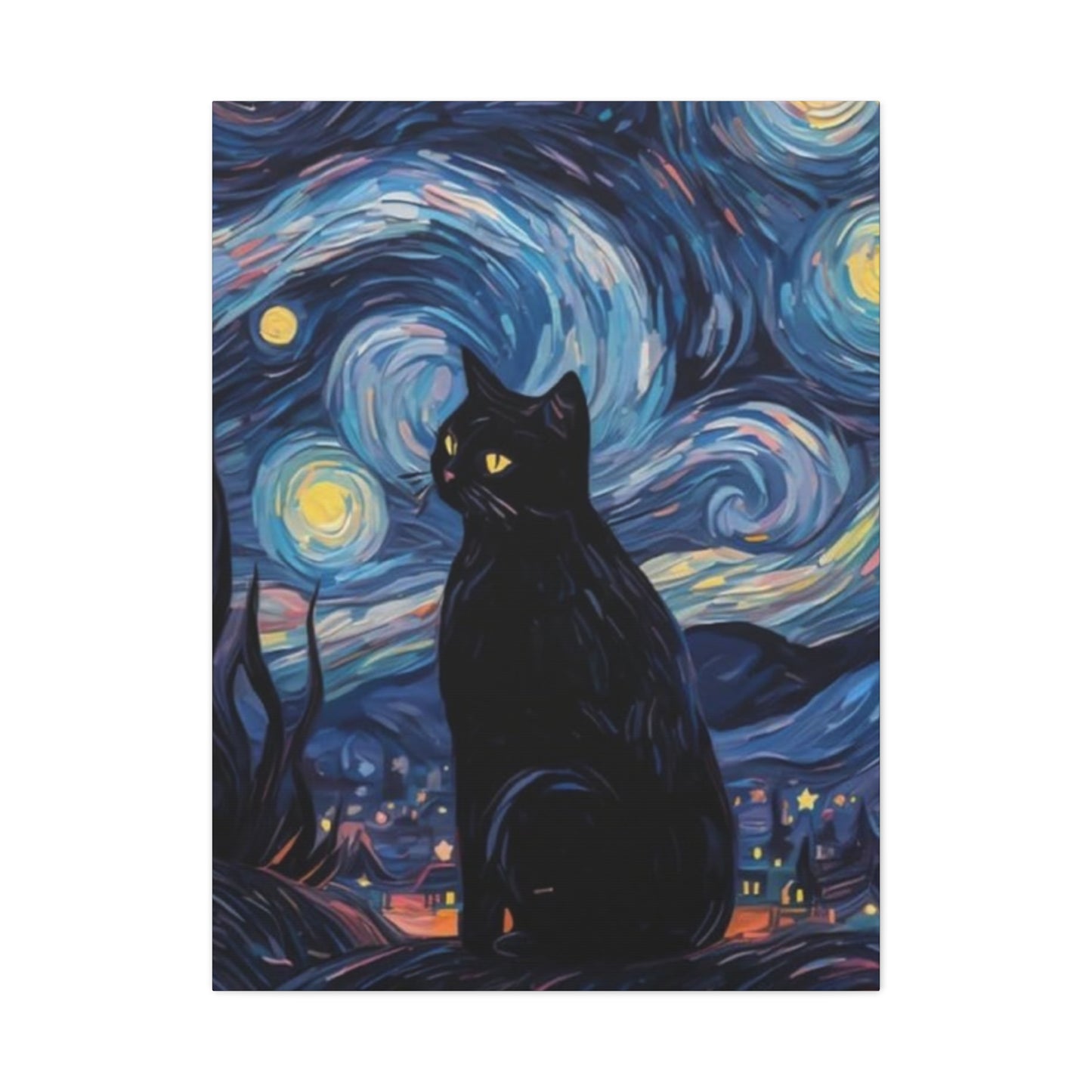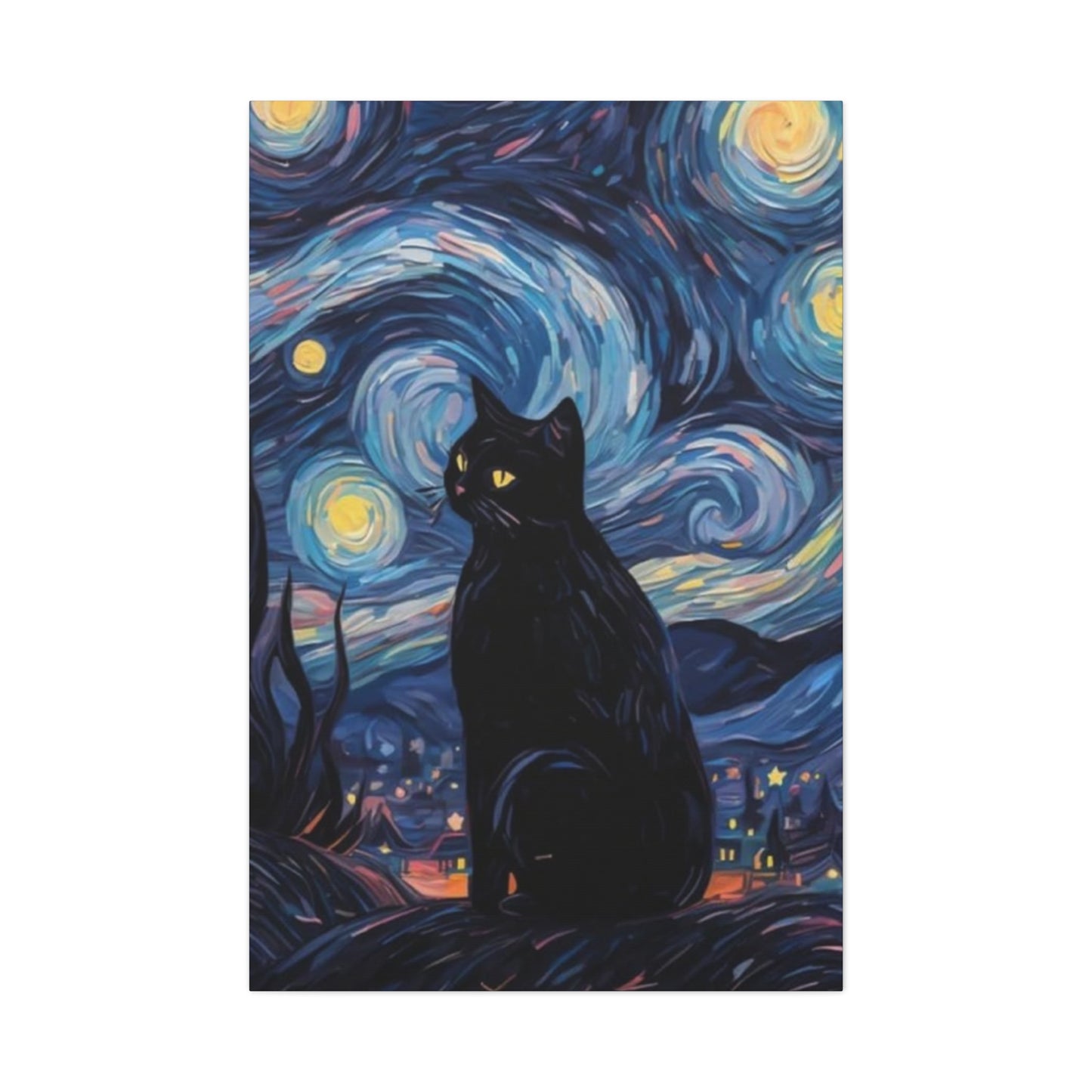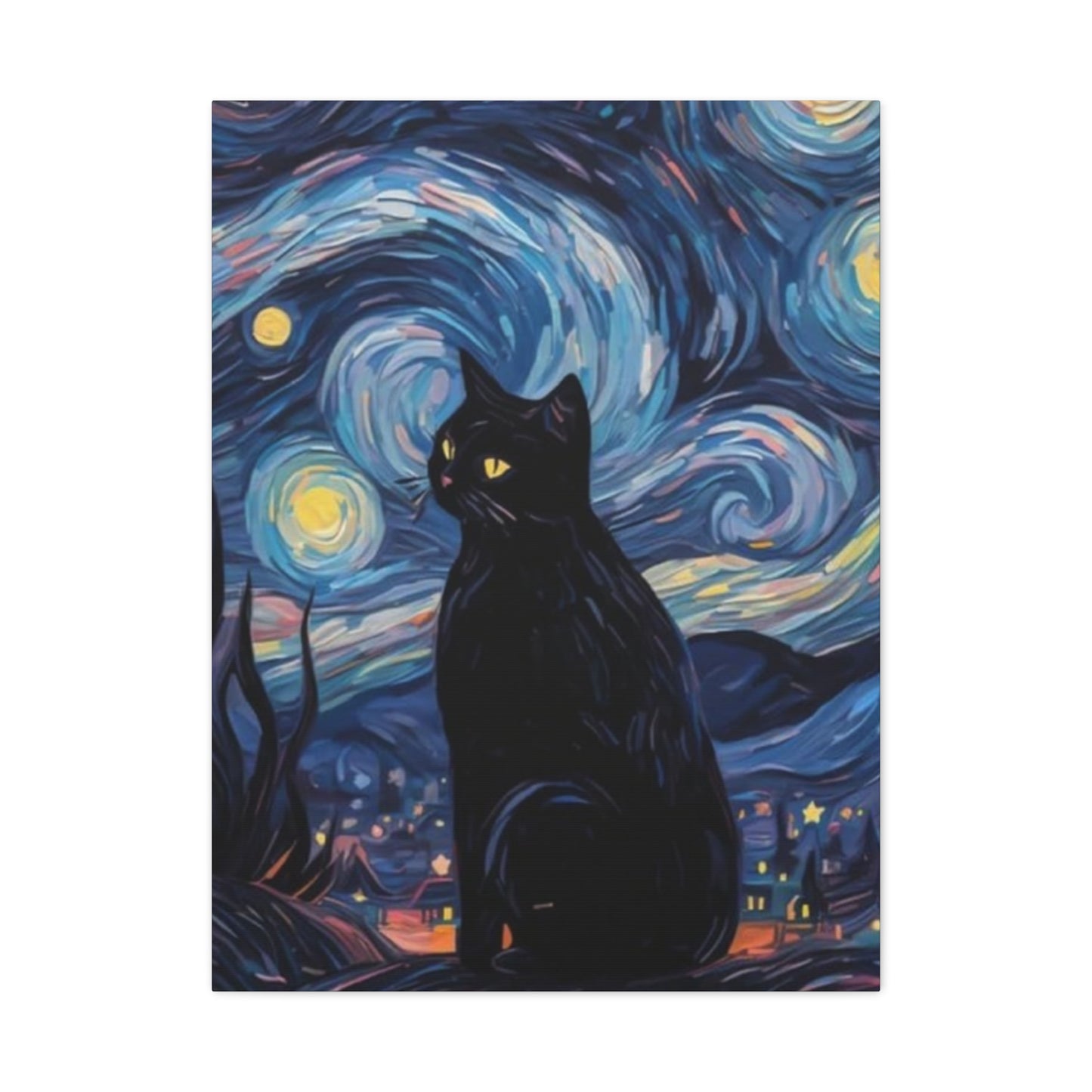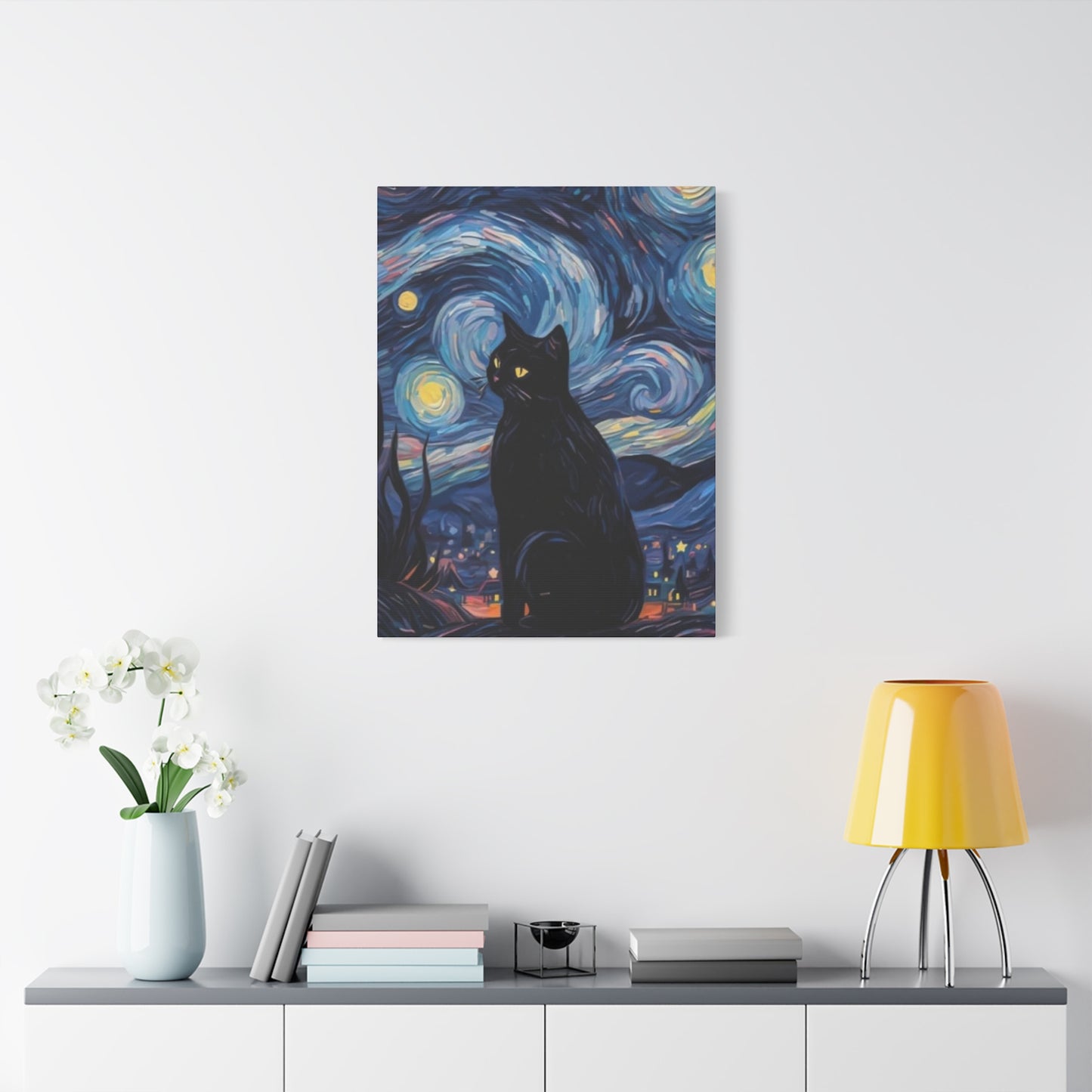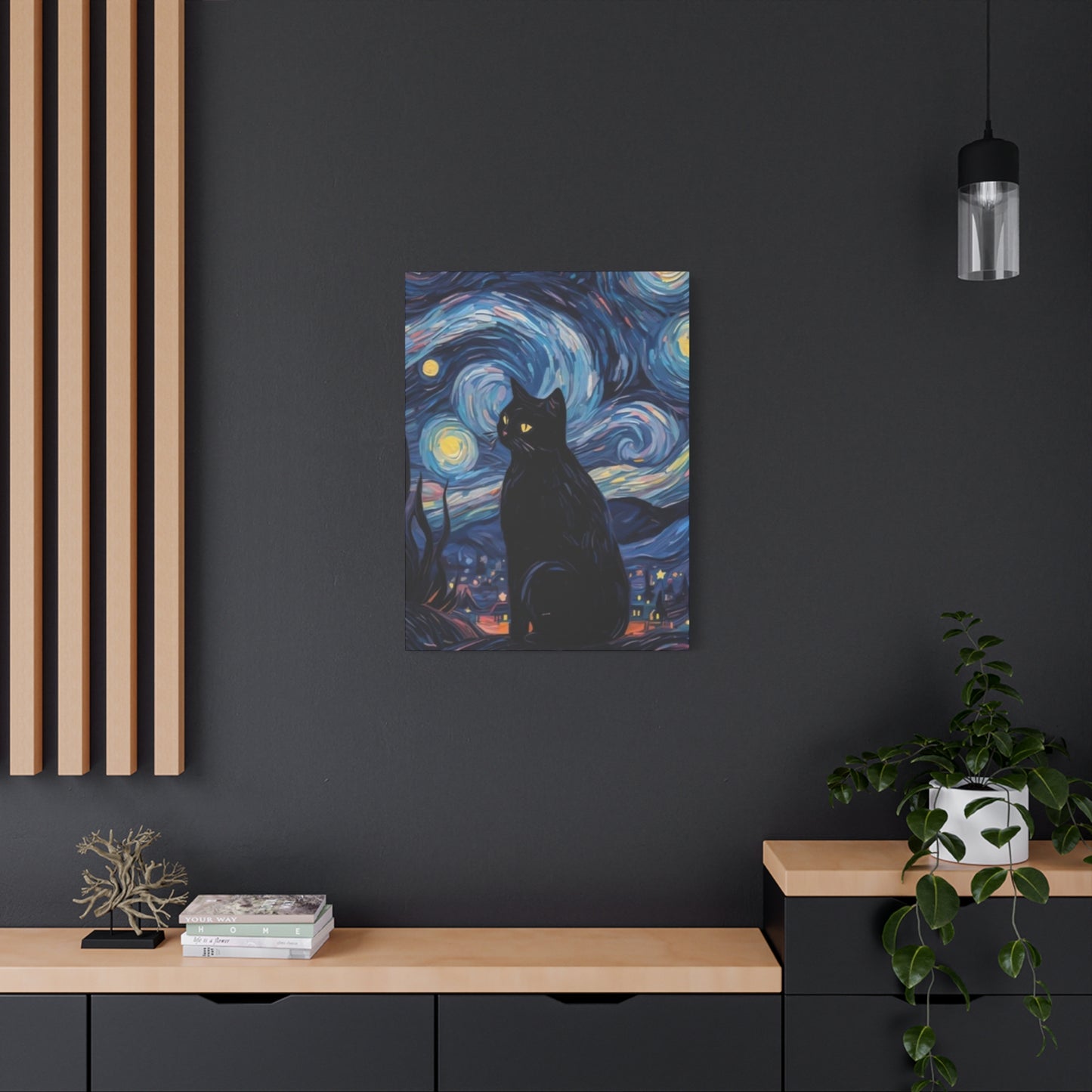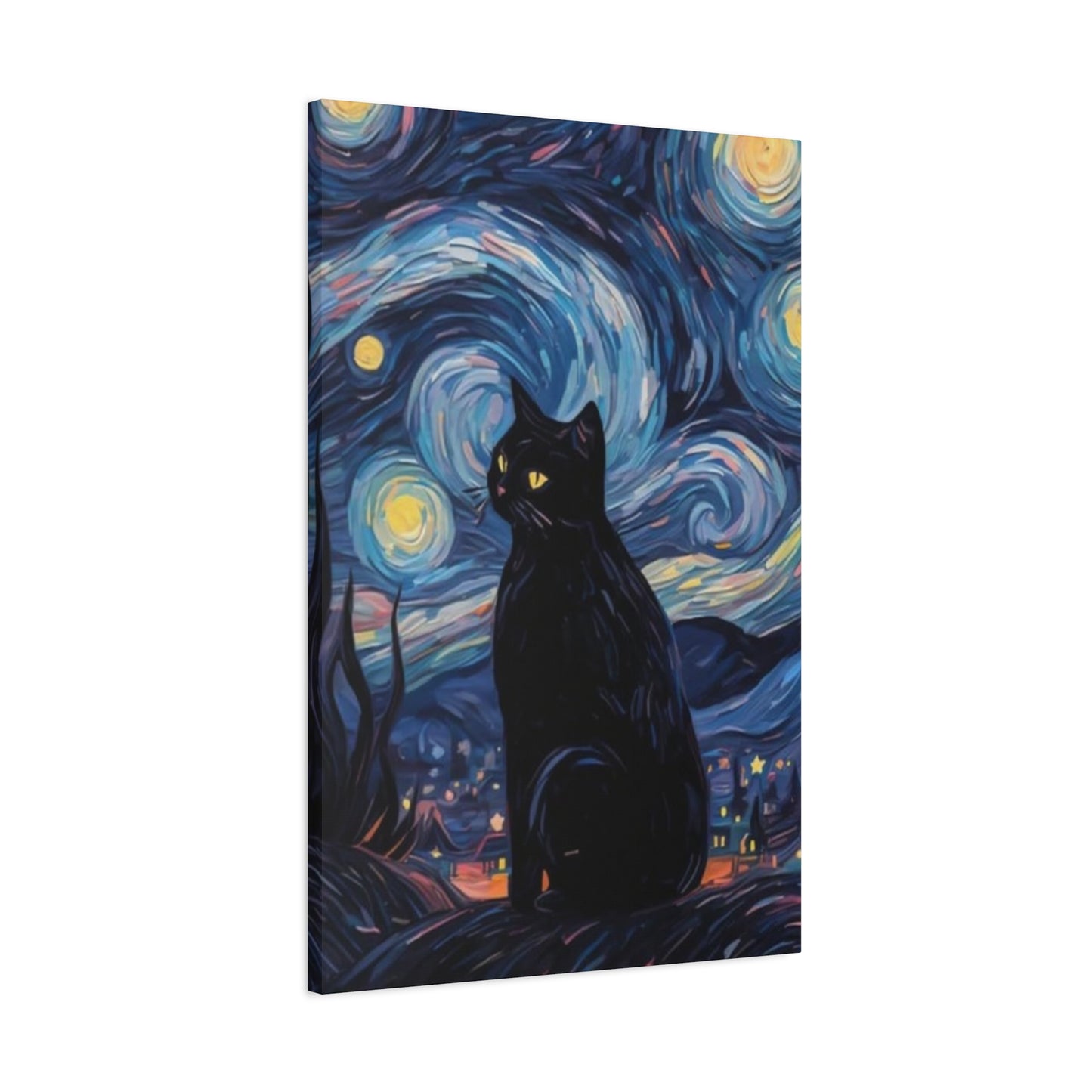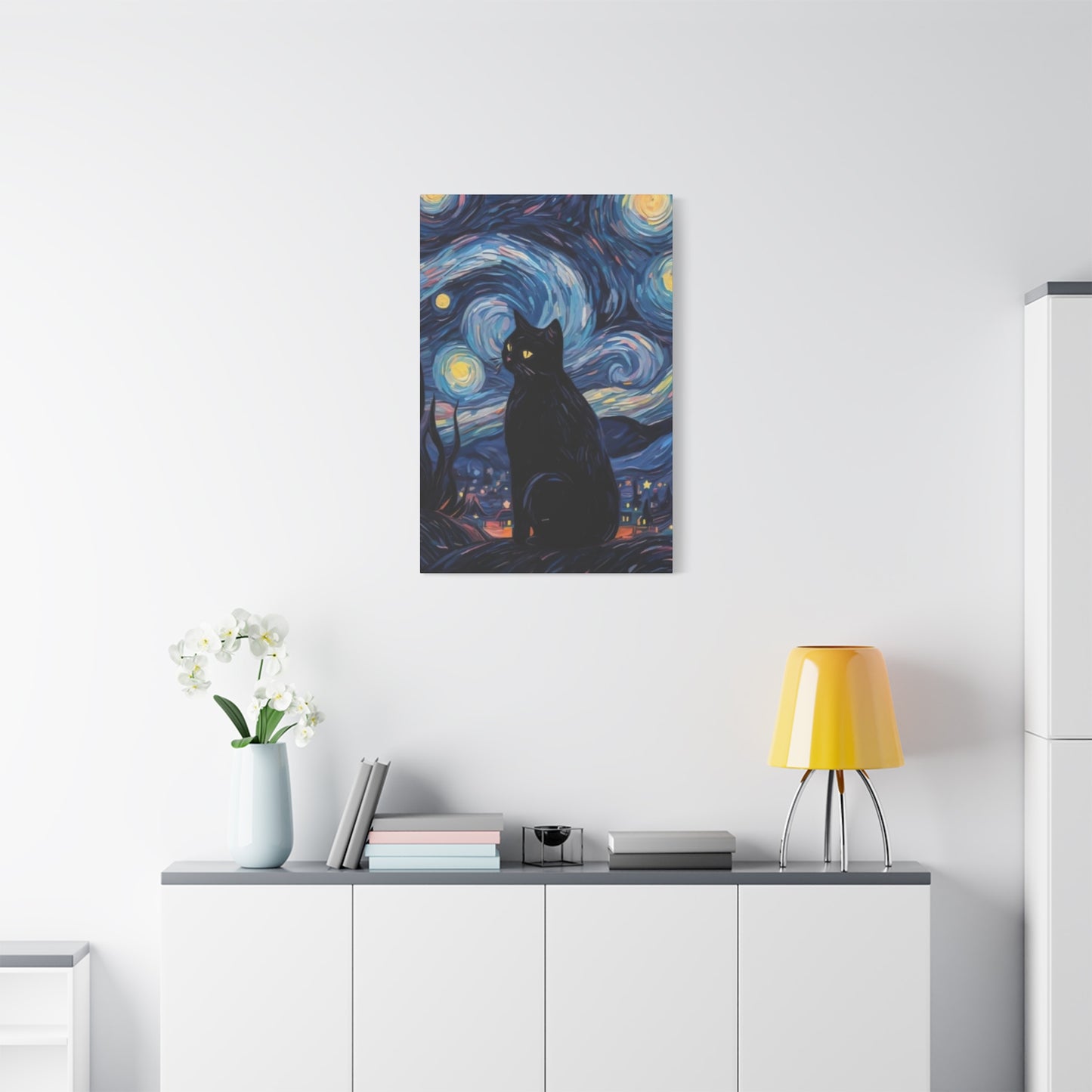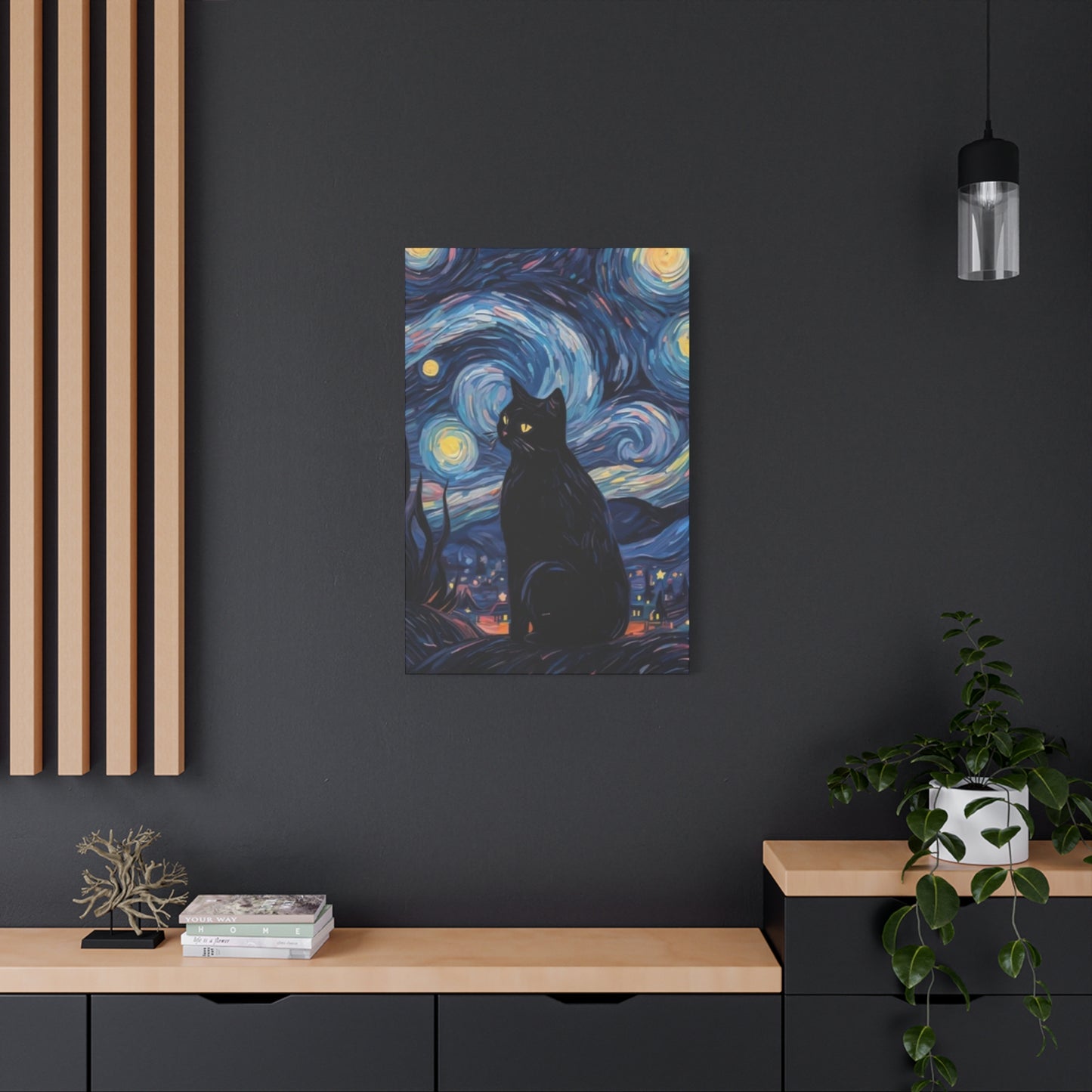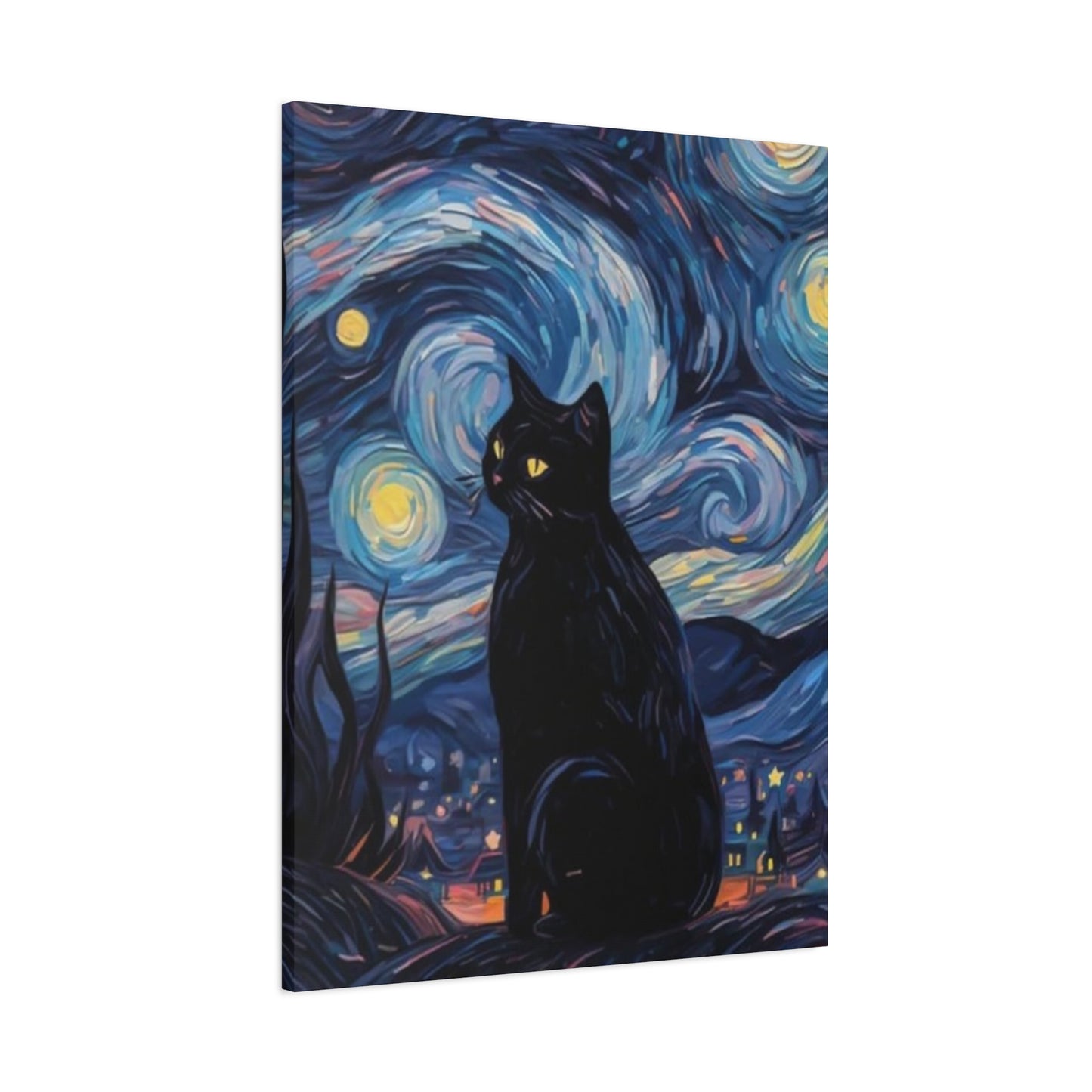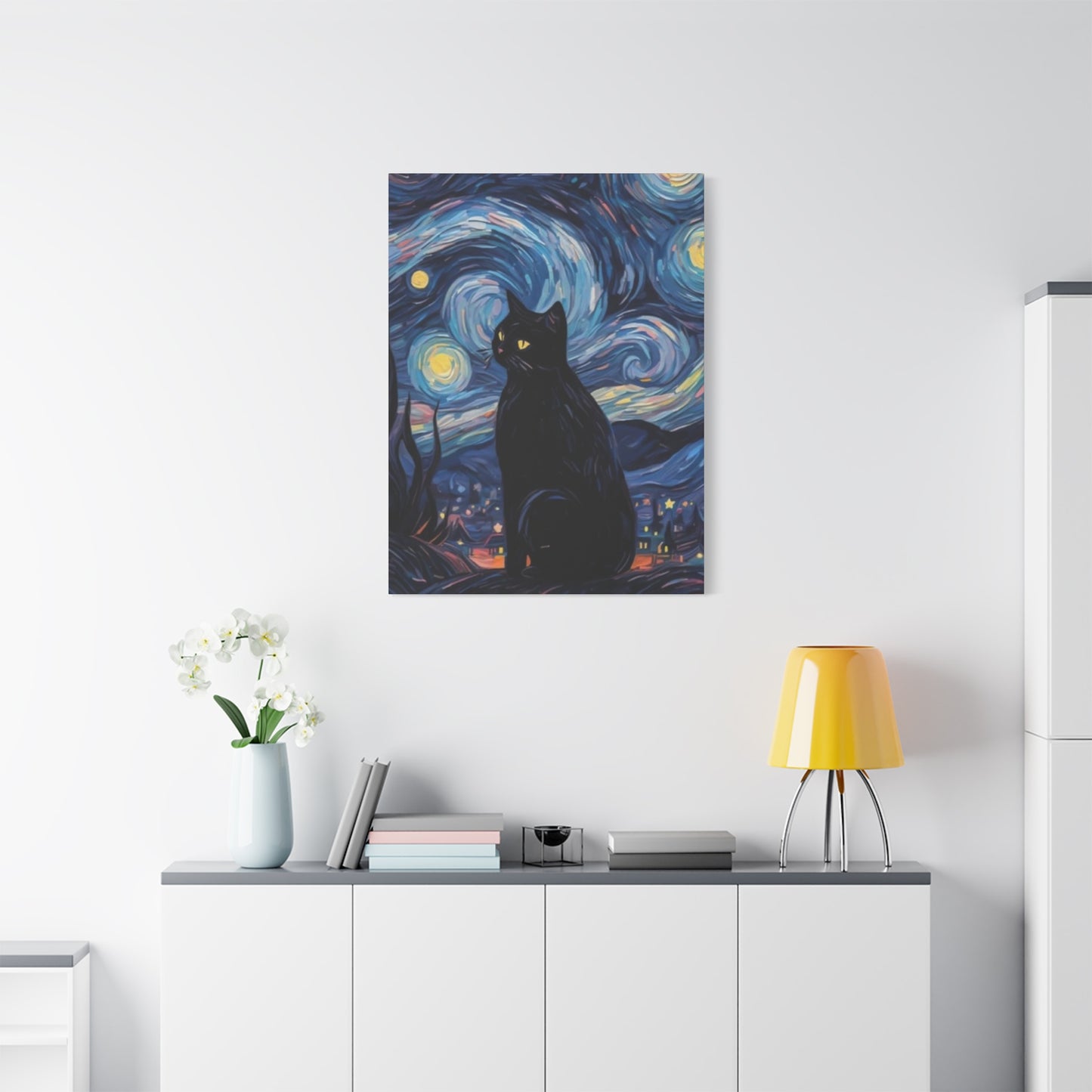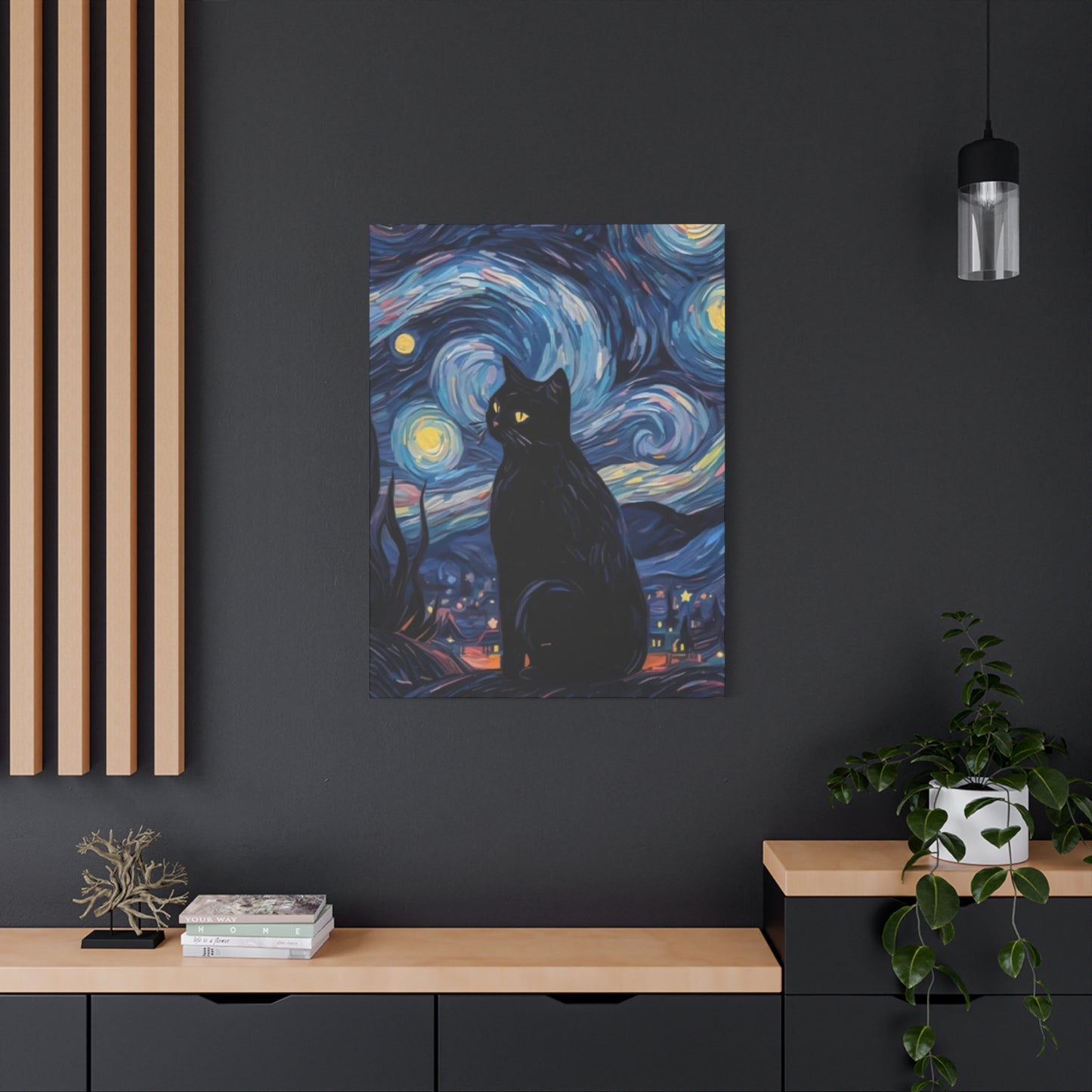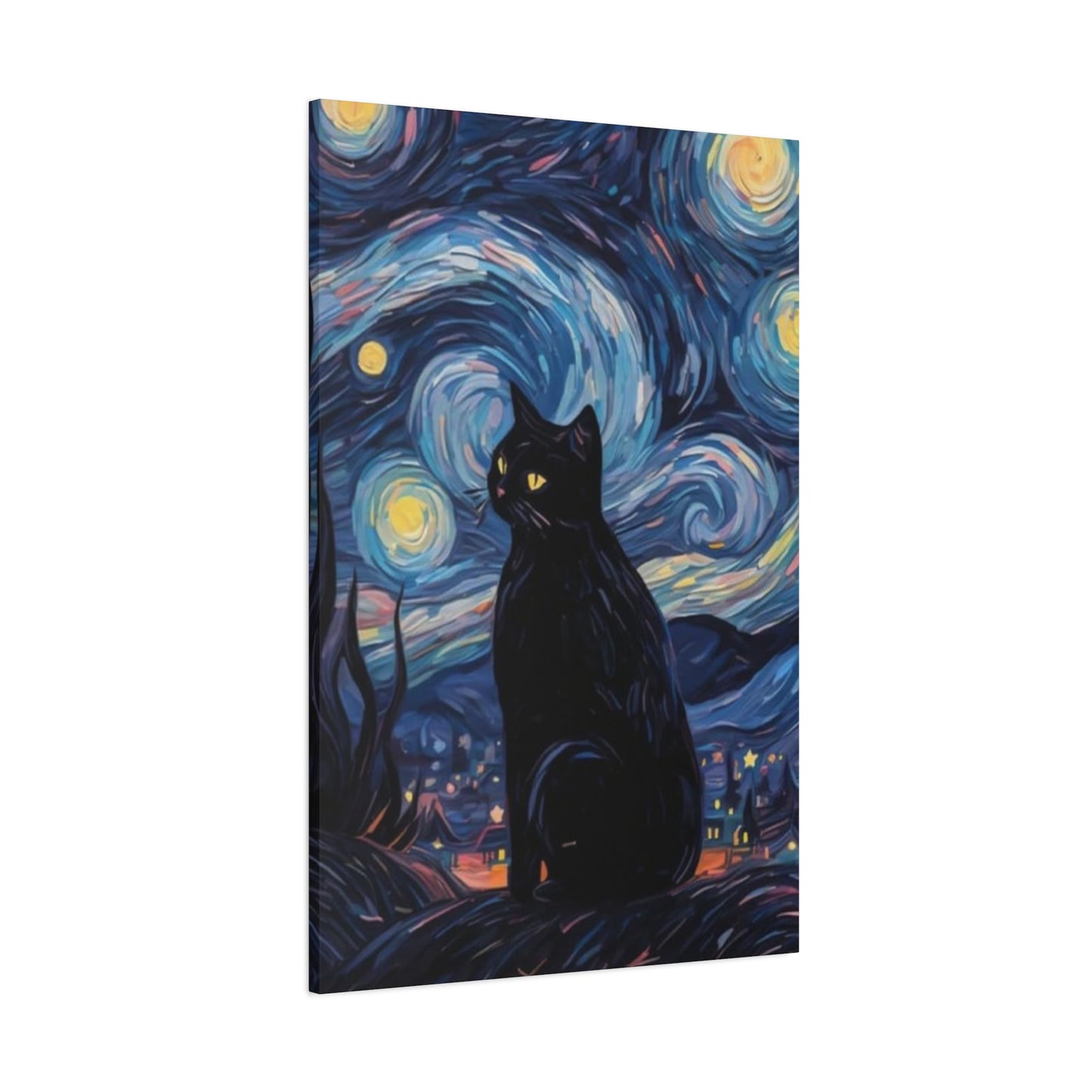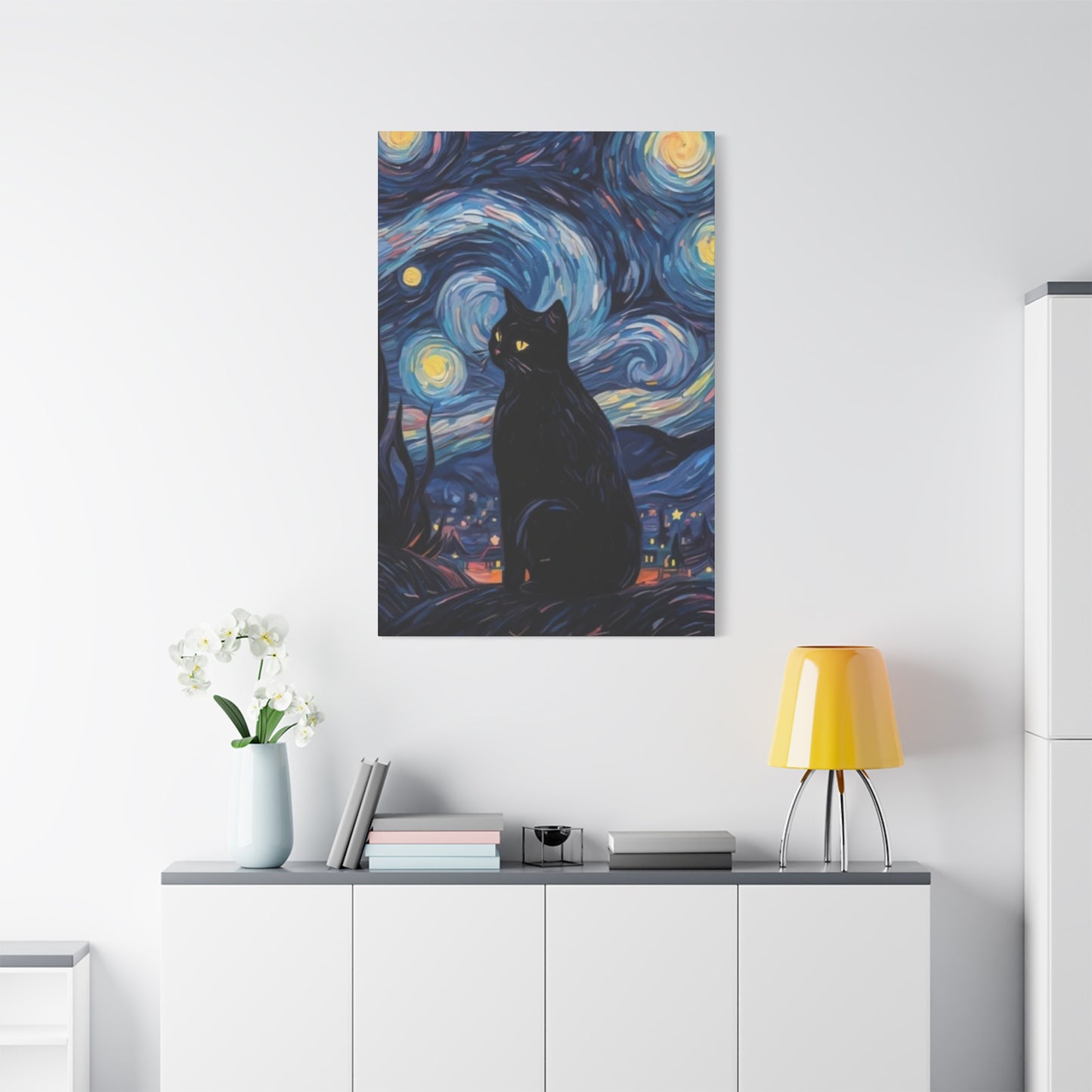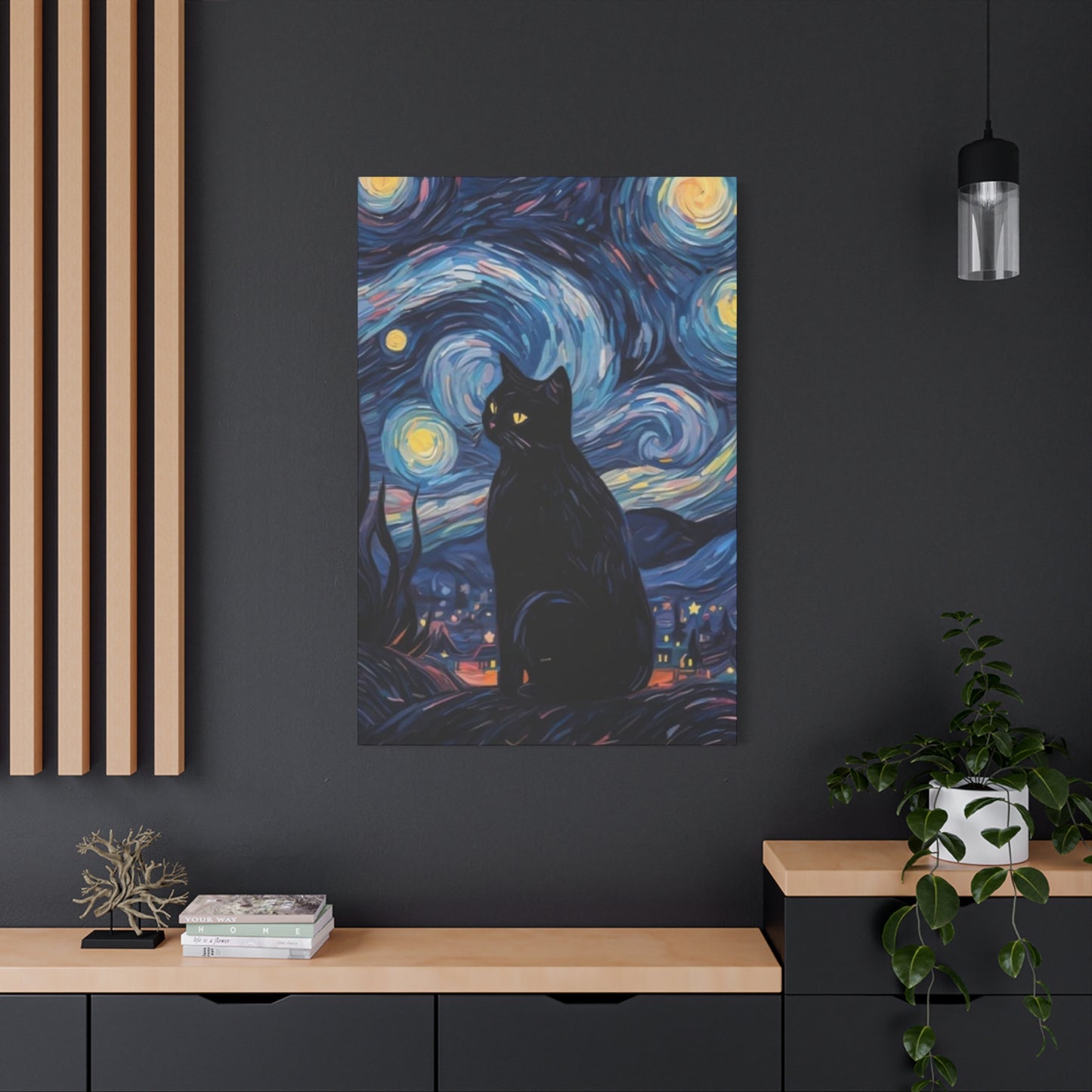Black Cats and Van Gogh-Inspired Abstract Art: A Journey Through Modern Canvas Expression
The intersection of feline mystique and post-impressionist artistry has created a fascinating movement in contemporary wall art. Black cats, long revered as symbols of mystery, elegance, and spiritual depth, have found their perfect artistic companion in the swirling, emotional brushstrokes reminiscent of Vincent van Gogh's revolutionary style. This convergence has birthed a unique aesthetic that speaks to both cat enthusiasts and art lovers, creating pieces that transform ordinary living spaces into galleries of emotional resonance and visual sophistication.
The appeal of combining black cats with Van Gogh-inspired techniques lies in their shared ability to evoke powerful emotions through seemingly simple subjects. Just as Van Gogh found profound beauty in sunflowers, starry nights, and everyday scenes, modern artists have discovered the rich symbolic potential of the black cat as a subject worthy of abstract interpretation. These artworks capture not just the physical beauty of these magnificent creatures, but their enigmatic presence, their graceful movements, and the cultural mythology that surrounds them.
In today's interior design landscape, homeowners increasingly seek artwork that tells a story while complementing their personal aesthetic. Black cat abstract art inspired by Van Gogh's techniques offers exactly this combination - pieces that are both visually striking and emotionally meaningful. Whether displayed in minimalist modern apartments, cozy traditional homes, or contemporary office spaces, these artworks serve as conversation starters and focal points that reflect the owner's appreciation for both artistic innovation and feline grace.
The evolution of this artistic niche reflects broader trends in contemporary art, where classical techniques meet modern sensibilities. Artists working in this style often employ Van Gogh's characteristic impasto technique, bold color choices, and dynamic brushwork to create interpretations of black cats that feel both timeless and thoroughly contemporary. The result is artwork that honors the master's legacy while establishing its own unique voice in the modern art world.
Black Cats in Modern Art
The representation of black cats in contemporary artistic expression has undergone a remarkable transformation over the past several decades. Modern artists have moved far beyond traditional realistic portrayals, embracing abstract and impressionistic techniques that capture the essence and mystique of these enigmatic creatures. This evolution reflects changing cultural perceptions of black cats, from supernatural associations to celebrations of their inherent beauty and grace.
Contemporary artists working with black cat imagery often focus on the interplay of light and shadow that these dark-coated felines naturally create. The absence of color in their fur becomes a canvas for exploring texture, movement, and form in ways that wouldn't be possible with more colorful subjects. Artists like contemporary painter Sarah Mitchell have built entire careers around abstract representations of black cats, using bold brushstrokes and unexpected color combinations to convey the emotional depth these animals represent in human culture.
The symbolism embedded in modern black cat art extends beyond mere aesthetic appeal. These pieces often explore themes of independence, mystery, intuition, and the feminine divine - concepts that resonate strongly with contemporary audiences seeking artwork that reflects their personal values and beliefs. Many collectors find that black cat art serves as a daily reminder of these qualities, making it particularly popular among individuals who identify with the independent and mysterious nature traditionally associated with felines.
Digital art platforms have also embraced the black cat motif, with countless artists creating everything from minimalist line drawings to complex digital paintings that blend traditional techniques with modern technology. This accessibility has democratized black cat art, allowing emerging artists to experiment with the subject matter while building audiences through social media and online galleries.
The therapeutic aspects of black cat art cannot be overlooked. Many art therapists report that clients find working with black cat subjects particularly calming and centering. The flowing lines and organic shapes associated with feline forms naturally lend themselves to meditative artistic practices, while the cultural associations with cats as healing companions add another layer of psychological benefit to both creating and viewing these artworks.
Gallery exhibitions featuring black cat art have become increasingly popular in major cities worldwide. Museums have begun recognizing this niche as a legitimate artistic movement worthy of scholarly attention. The Museum of Contemporary Art in Los Angeles recently featured an exhibition titled "Shadow and Grace" dedicated entirely to contemporary interpretations of black cats in art, drawing record crowds and cementing the subject's place in serious artistic discourse.
Commercial applications of black cat art have expanded dramatically, with interior designers frequently incorporating these pieces into both residential and commercial spaces. Hotels, restaurants, and retail establishments have discovered that black cat art creates an atmosphere of sophistication and intrigue that appeals to a broad demographic while maintaining cultural relevance and artistic integrity.
The intersection of black cat imagery with other artistic movements has produced fascinating hybrid styles. Neo-expressionist artists have embraced the dramatic potential of black cats, while pop artists have reimagined them through contemporary cultural lenses. This versatility demonstrates the enduring appeal and adaptability of the subject matter across various artistic contexts and movements.
Van Gogh's Abstract Influence
Vincent van Gogh's revolutionary approach to color, texture, and emotional expression continues to inspire contemporary artists more than a century after his death. His unique ability to transform ordinary subjects into extraordinary emotional experiences through bold brushwork and innovative color theory has become a foundational influence for modern abstract artists, particularly those working with animal subjects like black cats.
The Dutch master's technique of using thick, visible brushstrokes to create texture and movement translates beautifully to contemporary cat art. Modern artists applying Van Gogh-inspired methods to black cat subjects often employ his characteristic impasto technique, building up paint in thick layers that create a three-dimensional quality on the canvas. This approach allows the artist to capture the luxurious texture of cat fur while maintaining the emotional intensity that Van Gogh brought to all his work.
Van Gogh's fearless use of color provides a perfect framework for artists seeking to move beyond literal representation of black cats. While the cats themselves may be predominantly dark, the backgrounds, shadows, and highlights can explode with the kind of vibrant yellows, blues, and greens that characterized Van Gogh's palette. This creates a dynamic tension between the subject and its environment that captures both the mystery of the black cat and the emotional intensity of Van Gogh's style.
The psychological depth that Van Gogh brought to his work resonates particularly well with black cat subjects. Just as Van Gogh could find profound meaning in a simple sunflower or chair, contemporary artists influenced by his approach discover layers of symbolism and emotional content in the graceful form of a resting or prowling black cat. This psychological approach to art-making transforms what could be simple pet portraits into complex explorations of mood, atmosphere, and meaning.
Van Gogh's letters to his brother Theo reveal his deep understanding of how art can serve as a vehicle for emotional communication. This philosophy has been embraced by contemporary artists creating black cat art, who often describe their work as attempts to capture and convey the emotional bond between humans and felines. The result is artwork that functions not just as decoration, but as a means of emotional expression and connection.
The master's approach to composition, particularly his use of swirling, dynamic lines, has proven especially effective when applied to cat subjects. The natural grace and fluidity of feline movement align perfectly with Van Gogh's rhythmic brushwork, creating compositions that feel both structured and spontaneous. This combination of controlled technique and emotional freedom produces artwork that captures the essential nature of both the artistic influence and the subject matter.
Modern technology has enabled artists to study Van Gogh's techniques in unprecedented detail, leading to more sophisticated applications of his methods to contemporary subjects. High-resolution scans of Van Gogh's paintings reveal the precise way he built up paint layers and created texture, knowledge that contemporary black cat artists use to create pieces that honor his legacy while establishing their own artistic voice.
Educational institutions now offer specialized courses in applying Van Gogh's techniques to contemporary subjects, with black cat art serving as a popular focus. These programs teach students not just the technical aspects of Van Gogh's approach, but also his philosophical understanding of art as emotional communication. Graduates of these programs often go on to develop successful careers creating Van Gogh-inspired black cat art for both commercial and gallery markets.
The therapeutic applications of Van Gogh's techniques have gained recognition in art therapy circles. The physical act of applying thick paint in bold strokes, combined with the emotionally resonant subject matter of cats, creates a powerful therapeutic experience for participants. Mental health professionals report that clients working in Van Gogh-inspired styles with cat subjects often experience reduced anxiety and improved emotional expression.
Mystique of Black Cats on Canvas
The canvas becomes a portal to mystery when black cats emerge through artistic interpretation. Unlike any other feline color variant, black cats possess an inherent visual drama that translates magnificently to painted surfaces. Their solid, deep coloration creates opportunities for artists to explore the subtleties of shadow, the interplay of light, and the emotional weight that darkness can carry within a composition.
Artists working with black cat subjects often describe a unique challenge and reward system that comes with the territory. The absence of varied coloration in the cat's coat pushes painters to find creativity in texture, form, and the interaction between the subject and its environment. This limitation becomes a creative catalyst, forcing artists to develop sophisticated techniques for suggesting depth, movement, and personality through subtle variations in tone and brushwork rather than relying on obvious color contrasts.
The historical associations surrounding black cats add layers of meaning that contemporary artists can either embrace or subvert in their work. While some artists play into the mysterious, magical associations, others work deliberately to present black cats as symbols of elegance, sophistication, and natural beauty. This tension between cultural perception and artistic reality creates rich ground for meaningful artistic exploration and social commentary through visual art.
Canvas preparation becomes particularly crucial when working with black cat subjects. Artists must consider how the ground color and texture will interact with the predominantly dark pigments used to depict the cat. Many successful black cat painters prepare their canvases with warm undertones that will glow through the darker layers, creating depth and luminosity that prevents the finished work from appearing flat or lifeless.
The psychological impact of black cats on canvas extends beyond mere visual appeal. Viewers often report feeling drawn into the eyes of painted black cats in ways that don't occur with other animal subjects. This phenomenon may relate to the high contrast between the dark fur and bright eyes, or it could reflect deeper psychological associations with the mystery and intelligence traditionally attributed to black cats in various cultures.
Contemporary black cat canvas art often incorporates mixed media techniques that enhance the mystique of the subject. Artists might add metallic accents to suggest the shine of healthy fur, or use textural mediums to create the sensation of soft fur contrasting with rough environmental elements. These techniques transform the canvas from a flat surface into a rich, tactile experience that invites closer inspection and contemplation.
The scale of black cat canvas art plays a crucial role in its impact. Large-scale works create an immersive experience where the viewer feels enveloped by the cat's presence, while smaller intimate pieces invite personal connection and quiet contemplation. Artists must carefully consider how the size of their work will affect the viewer's relationship with the subject and the emotional tone of the piece.
Lighting considerations become paramount when displaying black cat canvas art. The interplay between artificial lighting and the painted surface can dramatically alter the appearance and mood of the work. Professional galleries and discerning collectors often invest in specialized lighting systems that enhance rather than compete with the subtle tonal variations that make black cat art so compelling.
The mystique of black cats on canvas also extends to the artist's process. Many painters report entering an almost meditative state when working on black cat subjects, finding that the repetitive process of building up dark tones and searching for subtle variations creates a deeply focused, contemplative working experience. This meditative quality often translates to the finished work, imbuing it with a sense of calm presence that viewers find particularly appealing in today's fast-paced world.
Abstract Modernism Explained
Abstract modernism represents a revolutionary departure from representational art, emphasizing emotional expression, formal innovation, and conceptual depth over literal depiction. When applied to black cat subjects, this artistic movement creates opportunities for profound artistic exploration that goes far beyond simple animal portraiture. The principles of abstract modernism align beautifully with the inherent mystery and symbolic richness that black cats bring to artistic interpretation.
The foundation of abstract modernism lies in the rejection of traditional perspective, realistic proportions, and conventional color usage. Artists working in this style with black cat subjects often distort, fragment, or completely reimagine the feline form to convey emotional or conceptual content that couldn't be achieved through realistic representation. This freedom allows for artistic expressions that capture the essence of "cat-ness" rather than the mere appearance of any individual cat.
Color theory in abstract modernism takes on special significance when dealing with predominantly black subjects. Artists must master the subtle variations within dark tonalities while also understanding how contrasting colors can create emotional and visual tension. The challenge of working with limited local color pushes abstract modernist cat artists to develop sophisticated palettes that rely on temperature, intensity, and interaction rather than obvious hue variation.
Compositional strategies in abstract modernist black cat art often break traditional rules of balance and focal points. Artists might fragment the cat's form across the canvas, use negative space as an active compositional element, or create rhythmic patterns that suggest feline movement without literal depiction. These approaches require viewers to engage actively with the work, constructing meaning through personal interpretation rather than passive observation.
The philosophical underpinnings of abstract modernism emphasize the artwork's independence from external reality. When applied to black cat subjects, this means artists can explore themes of independence, mystery, and intuition through purely visual means rather than relying on narrative or symbolic elements. The resulting works function as visual poetry, conveying complex emotions and ideas through form, color, and composition alone.
Technical innovation has always been central to abstract modernism, and contemporary black cat artists continue this tradition by experimenting with new materials and methods. From incorporating digital elements into traditional paintings to using unconventional tools for mark-making, these artists push the boundaries of what cat art can be while maintaining connection to modernist principles of innovation and experimentation.
The relationship between abstraction and recognition becomes particularly interesting in black cat art. Artists must find the balance between abstracting their subject to the point where it becomes unrecognizable and maintaining enough visual cues that viewers can connect with the feline essence. This tension creates dynamic works that reward both casual viewing and deep contemplation.
Abstract modernist black cat art often functions as a meditation on the relationship between humans and animals. By removing literal representation, artists can focus on the emotional and spiritual connections that people feel with cats, creating works that speak to universal experiences of companionship, independence, and mutual respect between species.
Educational value in abstract modernist black cat art extends beyond art appreciation to include lessons in visual literacy and emotional intelligence. Viewers must develop skills in reading non-verbal visual communication while also connecting with their own emotional responses to color, form, and composition. This process of active engagement makes abstract modernist cat art particularly valuable in educational and therapeutic settings.
The market for abstract modernist black cat art has grown substantially as collectors recognize the sophisticated artistic content these works contain. No longer dismissed as simple pet art, the best examples of this genre are finding their way into serious collections and museum exhibitions, gaining recognition as legitimate contributions to the ongoing evolution of abstract art.
Van Gogh Meets Contemporary Art
The fusion of Vincent van Gogh's revolutionary techniques with contemporary artistic sensibilities has created a vibrant new movement that bridges historical significance with modern relevance. When this fusion is applied to black cat subjects, the result is artwork that honors the master's legacy while speaking directly to contemporary audiences' love for both artistic sophistication and feline companions.
Contemporary artists drawing from Van Gogh's approach to black cat subjects often begin with his fundamental understanding of color as an emotional language. While Van Gogh might have painted cats in realistic colors, modern interpretations feel free to explore how his brilliant yellows, deep blues, and vibrant greens might interact with or contrast against the silky blackness of cat fur. This color freedom creates opportunities for emotional expression that go far beyond literal representation.
The physical gesture that characterized Van Gogh's painting technique translates beautifully to contemporary cat art. Modern artists employing his methods often describe feeling connected to the master through the physical act of painting, using bold, confident brushstrokes that capture both the energy of Van Gogh's approach and the graceful movement inherent in feline subjects. This physical connection to art-making creates works that pulse with life and energy.
Digital technology has opened new possibilities for combining Van Gogh's techniques with contemporary black cat art. Artists can study high-resolution scans of Van Gogh's brushwork, analyzing the precise way he built up paint layers and created texture. This knowledge can then be applied to digital tools that simulate traditional painting techniques, creating works that maintain the essence of Van Gogh's approach while utilizing contemporary technology.
The psychological depth that Van Gogh brought to his work finds perfect expression in black cat subjects. Contemporary artists influenced by his approach often explore themes of solitude, contemplation, and emotional intensity that align with both Van Gogh's personal struggles and the cultural associations surrounding black cats. This psychological resonance creates artwork that functions as both visual experience and emotional exploration.
Installation art has embraced the Van Gogh-meets-contemporary approach to black cat subjects, creating immersive environments where viewers can experience the emotional intensity of Van Gogh's style applied to feline subjects. These installations might include multiple canvases arranged to create narrative sequences or environmental installations where painted black cats interact with sculptural elements in gallery spaces.
The therapeutic applications of combining Van Gogh's techniques with cat subjects have gained recognition in art therapy practices. The combination of Van Gogh's emotionally expressive methods with the calming presence associated with cats creates powerful therapeutic experiences. Participants often report that working in Van Gogh-inspired styles with cat subjects helps them process difficult emotions while maintaining connection to positive, nurturing imagery.
Contemporary art criticism has begun to recognize the sophistication possible when Van Gogh's techniques are applied thoughtfully to black cat subjects. Critics note that the best examples of this fusion demonstrate not just technical skill in copying Van Gogh's methods, but genuine understanding of his artistic philosophy and ability to apply it meaningfully to contemporary subjects and concerns.
Educational programs combining Van Gogh studies with contemporary cat art have proven particularly effective in engaging students who might otherwise feel disconnected from historical art. The familiar appeal of cat subjects creates an entry point for deeper exploration of Van Gogh's revolutionary techniques and philosophical approach to art-making.
The commercial success of Van Gogh-inspired black cat art reflects broader cultural trends toward artwork that combines historical sophistication with contemporary appeal. Collectors appreciate owning pieces that demonstrate clear artistic lineage while maintaining relevance to modern life and values. This market demand has encouraged serious artists to explore the possibilities inherent in this fusion approach.
Black Cat Wall Art Trends
The contemporary wall art market has embraced black cat imagery with unprecedented enthusiasm, driven by changing cultural perceptions and sophisticated artistic interpretations that transform these enigmatic creatures into compelling focal points for modern interiors. Current trends in black cat wall art reflect broader movements in interior design while maintaining the unique appeal that makes feline art universally beloved across demographic lines.
Large-scale black cat artwork has become increasingly popular as homeowners seek to make bold statements with their wall art choices. These oversized pieces transform black cats from cute pet imagery into powerful artistic statements that command attention and respect in any room. Artists creating large-scale black cat works often employ dramatic compositions and bold color contrasts that make the most of the increased canvas real estate while maintaining the intimate connection that makes cat art so appealing.
Minimalist approaches to black cat wall art have gained traction among collectors who appreciate subtle sophistication over obvious decoration. These pieces often feature clean lines, limited color palettes, and generous use of negative space that allows the essential grace and elegance of the black cat form to shine without competition from busy backgrounds or complex compositions. The result is artwork that enhances rather than overwhelms contemporary living spaces.
Mixed media black cat wall art represents one of the most innovative trends in the current market. Artists are combining traditional painting techniques with collage elements, textural materials, and even sculptural components to create pieces that engage multiple senses and viewing experiences. These works often incorporate actual materials that reference the cat's environment - fabric that suggests soft fur, metallic elements that catch light like cat eyes, or textural components that invite tactile interaction.
The vintage aesthetic has influenced black cat wall art trends, with many contemporary artists creating pieces that deliberately reference historical artistic styles while maintaining modern appeal. Art Deco influences appear frequently in stylized black cat compositions, while Arts and Crafts movement aesthetics inform pieces that emphasize handcrafted quality and natural materials. These vintage-inspired works appeal to collectors seeking artwork that feels both timeless and contemporary.
Digital art has revolutionized black cat wall art production and distribution, allowing artists to create sophisticated pieces that can be reproduced as high-quality prints for broader market accessibility. Digital tools enable precise control over color, composition, and detail that would be difficult or impossible to achieve with traditional media alone. The result is black cat wall art that maintains fine art quality while remaining accessible to a broader range of collectors.
Seasonal and thematic variations in black cat wall art have become increasingly sophisticated, moving beyond simple Halloween associations to explore themes like winter elegance, spring renewal, and summer languor through feline imagery. These seasonal approaches allow collectors to rotate their wall art throughout the year while maintaining consistent aesthetic themes centered around their appreciation for black cats.
The influence of social media on black cat wall art trends cannot be understated. Platforms like Instagram and Pinterest have created communities of black cat art enthusiasts who share images, discuss techniques, and support artists creating in this niche. This online community has helped establish quality standards and pushed artists to create increasingly sophisticated works that stand out in crowded digital spaces.
Sustainability concerns have influenced black cat wall art trends, with increasing numbers of artists using eco-friendly materials and production methods. Recycled canvas, non-toxic paints, and local sourcing have become selling points for environmentally conscious collectors who want their art purchases to align with their values. This trend toward sustainability has also encouraged innovation in materials and techniques that create unique aesthetic effects while reducing environmental impact.
The therapeutic market for black cat wall art has expanded significantly as mental health professionals recognize the calming and centering effects these images can have in clinical and home settings. Artwork specifically designed for therapeutic environments often emphasizes soft colors, gentle compositions, and peaceful imagery that promotes relaxation and positive emotional states while maintaining the sophisticated aesthetic that makes quality art appealing in any context.
Modern Abstracts for Cat Lovers
The intersection of abstract art and feline appreciation has created a sophisticated niche that appeals to collectors seeking artwork that reflects both artistic sophistication and personal passion. Modern abstract interpretations of cats, particularly black cats, offer viewers the opportunity to engage with beloved subjects through innovative artistic lenses that reveal new possibilities for emotional and aesthetic connection.
Contemporary abstract artists working with cat subjects often focus on capturing the essence of feline grace through non-representational means. Rather than depicting recognizable cat forms, these artists might use flowing lines that suggest the curve of a cat's spine, color combinations that evoke the warmth of purring, or textural elements that remind viewers of soft fur. This approach creates artwork that speaks to cat lovers on an emotional level while maintaining the intellectual sophistication that makes abstract art compelling.
Color psychology plays a crucial role in modern abstract cat art designed for feline enthusiasts. Artists understand that cat lovers often associate specific colors with different aspects of their relationships with cats - warm oranges and reds might represent the comfort of a purring cat, while cool blues and purples could suggest the mystery and independence that draws people to feline companions. By manipulating these color associations through abstract techniques, artists create works that resonate deeply with their intended audience.
The therapeutic value of abstract cat art has gained recognition among both artists and collectors who are cat lovers. Many report that viewing or creating abstract interpretations of cats provides a meditative experience that connects them with their feelings about their feline companions while engaging their appreciation for visual art. This dual appeal makes abstract cat art particularly valuable for collectors seeking artwork that serves multiple personal needs.
Scale and composition in modern abstract cat art often reference the intimate nature of human-cat relationships. Artists might create small, jewel-like pieces that invite close inspection and personal contemplation, or large immersive works that envelop viewers in the emotional atmosphere of feline companionship. The choice of scale significantly affects how viewers interact with and interpret the abstract feline content.
Textural innovation has become a hallmark of contemporary abstract cat art. Artists experiment with materials and techniques that reference the tactile experience of interacting with cats - rough textures might suggest the rasp of a cat's tongue, while smooth, flowing passages could evoke the sensation of stroking soft fur. These tactile references create multi-sensory experiences that engage cat lovers on levels beyond mere visual appreciation.
The market for modern abstract cat art has developed its own sophisticated collector base that understands and appreciates the unique challenges and rewards of this artistic niche. Collectors often seek pieces that demonstrate not just abstract artistic skill, but genuine understanding of feline behavior and the human-cat relationship. This specialized knowledge creates a more engaged and discerning market that pushes artists to develop increasingly sophisticated approaches to their subject matter.
Installation possibilities for abstract cat art have expanded beyond traditional wall-mounted pieces to include sculptural elements, environmental installations, and interactive components. These expanded formats allow cat-loving collectors to integrate their appreciation for feline subjects throughout their living spaces in ways that feel natural and sophisticated rather than overwhelming or kitschy.
Educational value in abstract cat art extends to both art appreciation and animal behavior understanding. Viewers engaging with high-quality abstract cat art often develop enhanced visual literacy skills while also deepening their appreciation for the complexity and beauty of feline behavior and relationships. This educational component adds value that justifies the investment in original artwork rather than simple decorative pieces.
The evolution of digital tools has enabled abstract cat artists to experiment with techniques and effects that would be impossible with traditional media alone. Digital manipulation can create subtle color gradations, complex layering effects, and precise textural details that enhance the abstract representation of feline subjects. However, the best digital abstract cat art maintains the emotional authenticity that makes handmade art so compelling to serious collectors.
Van Gogh-Inspired Home Decor
The integration of Van Gogh-inspired artistic techniques into home decor has revolutionized how people think about incorporating fine art aesthetics into daily living spaces. When combined with beloved subjects like black cats, this approach creates home environments that feel both sophisticated and personally meaningful, transforming ordinary rooms into spaces that reflect artistic appreciation and individual personality.
Color schemes inspired by Van Gogh's bold palette choices provide the foundation for entire room designs built around black cat artwork. Deep blues reminiscent of "Starry Night," warm yellows from his sunflower series, and rich greens from his landscape work create sophisticated backdrops that make black cat art feel integrated rather than merely decorative. These color relationships demonstrate how Van Gogh's understanding of color harmony can inform comprehensive interior design approaches.
Textural elements throughout the home can reference Van Gogh's characteristic impasto technique, creating visual and tactile connections between artwork and environment. Throw pillows with heavily textured fabrics, area rugs with varied pile heights, and wall treatments that incorporate dimensional elements all serve to extend the artistic experience beyond the confines of framed artwork. This comprehensive approach creates living spaces that feel like extensions of the artistic vision rather than simple display areas.
Lighting design becomes crucial when displaying Van Gogh-inspired black cat art in home settings. The thick paint application characteristic of Van Gogh's technique creates subtle shadows and highlights that change dramatically under different lighting conditions. Homeowners investing in quality Van Gogh-inspired cat art often install adjustable lighting systems that allow them to control how their artwork appears at different times of day and for different moods or occasions.
Furniture selection can complement Van Gogh-inspired black cat decor by incorporating pieces that reference his artistic philosophy and aesthetic preferences. Rustic wooden pieces with visible grain and texture align with Van Gogh's appreciation for natural materials and honest construction, while curved lines in furniture design can echo the flowing brushstrokes characteristic of his painting style. The result is furnishing choices that feel harmonious with the artwork rather than competing for attention.
Seasonal decoration takes on new dimensions when working with Van Gogh-inspired black cat themes. Spring arrangements might incorporate the bright colors and energetic brushwork of Van Gogh's flowering tree paintings, while winter decor could reference the moodier, more contemplative tones of his later works. This seasonal approach allows homeowners to maintain consistent artistic themes while varying the emotional tone of their spaces throughout the year.
The psychological impact of living with Van Gogh-inspired black cat decor extends beyond mere aesthetic appreciation. Many homeowners report that surrounding themselves with art that combines Van Gogh's emotional expressiveness with the comforting presence of cat imagery creates home environments that feel both stimulating and soothing. This combination supports both creative thinking and emotional well-being in daily life.
Kitchen and dining room applications of Van Gogh-inspired black cat decor require special consideration of practical concerns while maintaining artistic integrity. Food-safe materials, easy cleaning requirements, and appropriate scale for functional spaces all factor into successful integration of artistic themes into these work areas of the home. The challenge is maintaining the emotional impact of the artistic vision while accommodating the practical demands of daily life.
Bedroom applications of Van Gogh-inspired black cat decor focus on creating restful environments that maintain artistic sophistication without becoming overstimulating. Softer interpretations of Van Gogh's techniques, more muted color palettes, and smaller-scale artworks often work better in sleeping spaces while still providing the visual interest and personal meaning that make this decorative approach so appealing to homeowners.
The resale value of homes decorated with high-quality Van Gogh-inspired black cat art often exceeds that of homes with more conventional decoration. Real estate professionals report that buyers frequently respond positively to homes that demonstrate artistic sophistication and personal character, particularly when the artistic choices are executed with quality materials and professional installation. This practical benefit provides additional justification for investing in original artwork and comprehensive design approaches.
Abstract Art That Speaks Emotion
The power of abstract art to communicate emotional content without relying on literal representation reaches its full potential when applied to subjects that carry strong emotional associations. Black cats, with their rich symbolic heritage and universal appeal as companion animals, provide ideal subjects for abstract artists seeking to create works that engage viewers on profound emotional levels while maintaining sophisticated artistic content.
Color relationships in emotionally driven abstract cat art often abandon realistic representation entirely in favor of palettes that directly express emotional states. An artist might use warm reds and oranges to convey the comfort and affection associated with a purring cat, or explore cool blues and purples to express the mystery and independence that draws people to feline companions. These color choices work independently of the cat's actual coloration to create direct emotional communication between artwork and viewer.
Brushwork and mark-making techniques become emotional languages in abstract cat art, with different approaches conveying distinct emotional messages. Smooth, flowing strokes might suggest the peaceful contentment of a sleeping cat, while energetic, gestural marks could capture the excitement of play or the intensity of a hunting focus. Artists working in this mode develop personal vocabularies of marks that allow them to paint emotions rather than appearances.
Compositional strategies in emotionally expressive abstract cat art often break conventional rules of balance and focal points to create psychological effects. Asymmetrical compositions might suggest the unpredictable nature of cats, while central focal points could emphasize the magnetic attraction that cats hold for their human companions. These compositional choices guide viewer attention and emotional response in subtle but powerful ways.
The scale of emotionally driven abstract cat art significantly impacts its psychological effect on viewers. Intimate small works invite personal, contemplative engagement that mirrors the private moments people share with their cats, while large-scale pieces can create immersive emotional experiences that envelop viewers in the feelings associated with feline companionship. Artists must carefully consider how scale affects emotional communication when developing their concepts.
Textural variety in abstract cat art serves as another channel for emotional expression, with different surface treatments suggesting various aspects of the human-cat relationship. Smooth areas might represent the peaceful aspects of cat companionship, while rough, heavily worked passages could express the passionate attachment that cat lovers feel. These textural contrasts create rich, multi-layered viewing experiences that reward extended contemplation.
The therapeutic applications of emotionally expressive abstract cat art have gained recognition in both clinical and private settings. Mental health professionals report that clients often find these works particularly effective for processing feelings about relationships, independence, and emotional security - themes that resonate with the cultural associations surrounding cats. The abstract nature of the work allows viewers to project their own experiences while maintaining safe distance from literal representation.
Memory and nostalgia play important roles in how viewers respond to emotionally driven abstract cat art. Many people have strong memories associated with cats from their past, and abstract representations can trigger these memories without the potential sadness that might accompany realistic portraits of specific animals no longer present. This indirect emotional access makes abstract cat art particularly valuable for people processing grief or celebrating joyful memories.
The market for emotionally expressive abstract cat art has developed sophisticated evaluation criteria that go beyond traditional measures of artistic skill to include the work's effectiveness in creating emotional connection. Collectors often describe their acquisition decisions in terms of how strongly they respond to pieces on an emotional level, and successful artists in this niche demonstrate consistent ability to create works that generate powerful viewer responses.
The evolution of this artistic approach has been influenced by advances in understanding emotional psychology and the human-animal bond. Contemporary artists creating emotionally expressive abstract cat art often incorporate knowledge from fields like animal behavior studies and attachment theory, using their artistic skills to visualize and communicate complex emotional concepts that might be difficult to express through other means.
Elegance of Black Cats in Art
The inherent elegance of black cats has captivated artists throughout history, but contemporary interpretations have elevated this appreciation to new levels of sophisticated artistic expression. The monochromatic beauty of black cats offers artists unique opportunities to explore form, grace, and movement without the distraction of varied coloration, creating works that celebrate the pure aesthetic qualities that make these animals so visually compelling.
The sculptural quality that black cats possess translates beautifully to artistic interpretation across various media. Their solid coloration emphasizes form over surface detail, allowing artists to focus on the essential elements of feline grace - the arch of a back, the curve of a tail, the alert tilt of an ear. This sculptural emphasis creates artwork that feels substantial and architecturally satisfying while maintaining the fluid organic qualities that make cats so visually appealing.
Light interaction with black cat subjects provides artists with sophisticated challenges and rewards that don't exist with other animal subjects. The way light catches on black fur, creating subtle highlights and deep shadows, offers opportunities for exploring the full range of tonal values within a limited color range. Master artists working with black cat subjects often develop extraordinary sensitivity to these subtle variations, creating works that demonstrate technical virtuosity while celebrating natural beauty.
The fashion-forward quality of black cats has influenced contemporary artistic interpretations that reference style, sophistication, and timeless appeal. Artists might incorporate elements from fashion illustration, graphic design, or luxury product photography to create black cat art that feels contemporary and stylish while honoring the natural elegance of their subjects. This approach appeals to collectors who appreciate both artistic quality and contemporary design sensibility.
Minimalist interpretations of black cat elegance have produced some of the most striking contemporary works in this genre. By reducing the cat form to its essential elements - perhaps just the curve of a spine or the angle of a sitting pose - artists create pieces that capture the essence of feline grace through economy of means. These minimalist approaches require exceptional skill in understanding what elements are truly essential to communicating the subject's essential character.
The psychological appeal of elegant black cat art extends beyond mere aesthetic appreciation to include deeper responses to the animals' cultural associations with sophistication, mystery, and refined taste. Collectors often report that living with high-quality black cat art makes them feel more sophisticated and culturally aware, suggesting that these works function as lifestyle accessories as well as artistic statements.
Historical art influences continue to inform contemporary interpretations of black cat elegance. References to Japanese ink painting traditions, European master drawings, and Art Deco design principles appear frequently in contemporary black cat art, creating works that demonstrate cultural literacy while maintaining contemporary relevance. These historical references add layers of meaning that reward educated viewing while remaining accessible to broader audiences.
The luxury market for elegant black cat art has developed its own standards and expectations that push artists to achieve exceptional levels of quality and refinement. Collectors in this market often have sophisticated understanding of art history and contemporary design, demanding works that demonstrate not just technical skill but also cultural awareness and innovative artistic vision. This demanding market environment encourages artists to continuously develop their skills and concepts.
Conclusion:
Black cats and Van Gogh-inspired abstract art represent a compelling fusion of whimsy, symbolism, and artistic innovation, offering a unique approach to modern interior décor. By blending the enigmatic charm of black cats with the expressive brushwork, vibrant color palettes, and dynamic compositions reminiscent of Van Gogh, these artworks create canvases that are visually striking, emotionally evocative, and deeply personal. Ideal for living rooms, studios, offices, or creative spaces, such art transforms walls into galleries of imagination and narrative, engaging viewers in a dialogue between tradition and contemporary expression.
The appeal of combining black cats with Van Gogh-inspired abstraction lies in the interplay of character, movement, and mood. Black cats symbolize mystery, independence, and elegance, while Van Gogh’s artistic style conveys emotion, energy, and depth. Together, they produce a visual language that balances the whimsical with the profound, allowing homeowners to bring both personality and sophistication into their interiors. This fusion invites viewers to explore texture, form, and color while connecting with familiar cultural and artistic references.
From a design perspective, these canvases are highly versatile. Large-scale prints can dominate a focal wall, anchoring a room with bold, expressive energy, while smaller pieces can be integrated into gallery walls or layered with complementary artworks for added depth. The vibrant, swirling patterns typical of Van Gogh-inspired abstraction introduce movement and rhythm, enlivening spaces and adding a dynamic contrast to neutral or minimalist interiors.

















